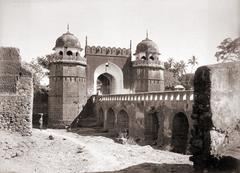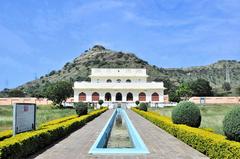Visiting Chand Minar in Aurangabad: A Complete Guide
Date: 19/07/2024
Introduction
Aurangabad, located in the Indian state of Maharashtra, is a city brimming with historical and cultural significance. Among its many attractions, the Chand Minar stands out as a remarkable example of medieval Indian architecture. Situated within the Daulatabad Fort complex, the Chand Minar was erected in 1445 CE by Ala-ud-din Bahmani, a ruler of the Bahmani Sultanate. This towering minaret not only showcases the architectural prowess of the period but also serves as a symbol of military victory and power. Visitors to the Chand Minar can expect to be awed by its intricate carvings, geometric patterns, and calligraphic inscriptions, which reflect a unique blend of Persian, Turkish, and Indian influences (source).
Understanding the historical context and architectural nuances of the Chand Minar enhances the visitor experience. The minaret’s construction was inspired by the Qutb Minar in Delhi, symbolizing the Bahmani Sultanate’s admiration for earlier Islamic structures. Standing at approximately 30 meters, the minaret is divided into four stories, each adorned with a projecting balcony. The use of stone and lime mortar at the base and intricate stucco work in the upper sections exemplifies the technological advancements of the time. Exploring the Chand Minar offers a glimpse into the rich cultural heritage and architectural syncretism of the Deccan region (source).
Table of Contents
- Introduction
- Historical Background
- Visitor Information
- Nearby Attractions
- Preservation and Conservation
- FAQs
- Conclusion
Historical Background
The construction of the Chand Minar was inspired by the Qutb Minar in Delhi, reflecting the Sultanate’s admiration for the architectural marvels of the earlier Delhi Sultanate. The minaret was erected to commemorate Ala-ud-din Bahmani’s conquest of the fort, symbolizing his military prowess and the consolidation of his power in the region.
Architectural Design
Structure and Dimensions
The Chand Minar stands at an impressive height of approximately 30 meters (98 feet), making it one of the tallest structures within the Daulatabad Fort complex. The minaret is divided into four distinct stories, each marked by a projecting balcony. The cylindrical structure tapers as it ascends, a common feature in Islamic minarets designed to create an illusion of greater height.
The base of the minaret is robust, constructed with stone and lime mortar, providing stability to the towering structure. The upper sections are adorned with intricate stucco work, showcasing the skilled craftsmanship of the period. The minaret’s design incorporates both functional and aesthetic elements, serving as a watchtower and a symbol of victory.
Decorative Elements
The Chand Minar is renowned for its elaborate decorative elements, which include intricate carvings, geometric patterns, and calligraphic inscriptions. The stucco work on the minaret features floral motifs and arabesques, reflecting the Persian influence on Bahmani architecture. The use of blue tiles in the decoration adds a vibrant contrast to the otherwise monochromatic stone structure.
The balconies on each story are supported by ornate brackets, showcasing the blend of structural engineering and artistic design. The calligraphic inscriptions, primarily in Arabic, include verses from the Quran and praises for Ala-ud-din Bahmani, highlighting the religious and political significance of the minaret.
Cultural and Historical Significance
Symbol of Power and Victory
The Chand Minar was constructed to commemorate Ala-ud-din Bahmani’s conquest of the Daulatabad Fort, symbolizing his military prowess and the consolidation of his power in the Deccan region. The minaret served as a visual representation of the Sultanate’s dominance, visible from a distance and instilling a sense of awe and reverence among the local populace.
Architectural Influence
The Chand Minar is a prime example of the architectural syncretism that characterized the Bahmani Sultanate. The minaret’s design draws inspiration from earlier Islamic structures, such as the Qutb Minar in Delhi, while incorporating local architectural traditions. This blend of styles is evident in the use of Persian decorative elements, Indian stone carving techniques, and the overall structural design.
The minaret’s construction also reflects the technological advancements of the period, particularly in the use of lime mortar and stucco work. The Chand Minar’s architectural significance lies in its ability to seamlessly integrate these diverse influences into a cohesive and aesthetically pleasing structure.
Visitor Information
Accessibility and Location
The Chand Minar is located within the Daulatabad Fort complex, approximately 15 kilometers from Aurangabad city. The fort is easily accessible by road, with regular bus and taxi services available from Aurangabad. Visitors can explore the fort complex, which includes several other historical structures, such as the Daulatabad Fort itself, the Chini Mahal, and the Baradari.
Guided Tours and Information
To fully appreciate the historical and architectural significance of the Chand Minar, visitors are encouraged to take guided tours offered by local tour operators. These tours provide detailed insights into the history of the Bahmani Sultanate, the construction of the minaret, and its cultural importance. Informational plaques and audio guides are also available within the fort complex, offering additional context and historical background.
Photography and Exploration
The Chand Minar is a popular spot for photography enthusiasts, offering stunning views of the surrounding landscape and the fort complex. Visitors are advised to bring cameras and capture the intricate details of the minaret’s stucco work and decorative elements. The balconies on each story provide unique vantage points for panoramic shots of the fort and the surrounding countryside.
Visiting Hours and Tickets
The Daulatabad Fort complex, which houses the Chand Minar, is open to visitors from 9:00 AM to 6:00 PM daily. The ticket prices for entry into the fort are as follows:
- Indian Nationals: INR 25 per person
- Foreign Nationals: INR 300 per person
It is advisable to check for any updates on the official Maharashtra Tourism website or at the ticket office before planning your visit.
Nearby Attractions
While visiting the Chand Minar, tourists can also explore other notable attractions in Aurangabad, such as the Bibi Ka Maqbara, Aurangabad Caves, and the Ellora Caves. These sites offer a glimpse into the rich historical and cultural heritage of the region.
Preservation and Conservation
Restoration Efforts
Over the centuries, the Chand Minar has faced the ravages of time and weather, leading to deterioration in some of its decorative elements and structural components. The Archaeological Survey of India (ASI) has undertaken several restoration projects to preserve the minaret’s historical and architectural integrity. These efforts include the reinforcement of the minaret’s base, the restoration of stucco work, and the cleaning of calligraphic inscriptions.
Visitor Guidelines
To ensure the preservation of the Chand Minar, visitors are requested to adhere to certain guidelines while exploring the site. These include avoiding touching or climbing on the minaret, refraining from defacing the structure, and following designated pathways. The ASI has also implemented measures to control the number of visitors at any given time, reducing the impact on the minaret and its surroundings.
FAQs
Q: What are the visiting hours for Chand Minar?
A: The Daulatabad Fort complex is open from 9:00 AM to 6:00 PM daily.
Q: How much do tickets to Chand Minar cost?
A: Ticket prices are INR 25 for Indian nationals and INR 300 for foreign nationals.
Q: What are some nearby attractions to Chand Minar?
A: Nearby attractions include Bibi Ka Maqbara, Aurangabad Caves, and the Ellora Caves.
Conclusion
The Chand Minar stands as a testament to the architectural brilliance and cultural syncretism of the Bahmani Sultanate. Its historical significance, intricate design, and towering presence make it a must-visit destination for history enthusiasts and architecture aficionados. By understanding and appreciating the minaret’s rich history and architectural nuances, visitors can gain a deeper insight into the cultural heritage of the Deccan region.
For more information about historical sites in Aurangabad or to plan your visit, download our mobile app Audiala, check out our related posts, and follow us on social media for updates.

